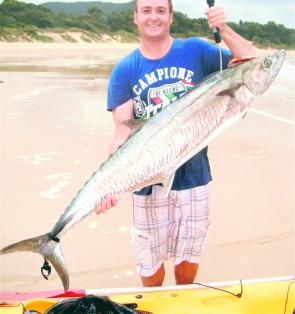This month brings a farewell to Summer but really, mild days and a fair bit of rain has been about the most of it.
This has mostly been due to the La Niña event, which we also hope to be saying farewell to, possibly during this month.
March should also mean we have said goodbye to half of our Summer visitors.
The human half has headed back to their normal homes. Tourist numbers have now dwindled to a slow trickle of grey nomads dropping in after the tourist season but before the warm(ish) season is finished.
Our beaches, rivers and bays are now filled with the weekend local crowd instead of the all-week tourist crowd ever-present over the past few months. Saying that, I extend a warm Coffs Harbour welcome to anyone visiting our marvellous region and I encourage anglers to come and see it for themselves, especially in the less frantic off-peak season.
The ‘other’ Summer tourists, the fish from up north, I now hope to spend a little more time with and they seem quite settled in for the rest of Autumn.
Spanish mackerel, although they didn’t arrive with a bang like last season, are around in good numbers and shadowing the bait schools around the reefs.
They, and their spotted cousins, have mostly been cruising close to shore and many have been caught around the headlands and shallow reefs, even in dirty water during the rain events.
This trend should continue throughout this month although we should hopefully get a little less rain than we had in January and February.
Both species of mackerel seem to be taking hard lures readily, as they did last season, as well as slowly trolled live baits. If last year is anything to go by they should hang around until well after Easter.
So far this season the wahoo haven’t been around in the same numbers as last year and this season’s offshore fishing has been quite different from 2011.
The most marked difference is the amount of bait.
Last year some fishos would have paid good money for just a couple of slimy mackerel, but this year they have been plentiful and large. Let’s hope this continues because it makes finding the predators a lot easier.
Other summer visitors have also been a bit patchy. Mahi mahi and longtail tuna have been caught here and there but have not shown up in consistent numbers yet.
The movements of mahi mahi are tied very closely to the warm current so if you can find pockets with bait in the warm EAC then that’s your best bet.
The longtails seem to have arrived a little later than last year but that can often be the case and it may mean they hang around a little longer.
The weakening La Niña should be great news to estuary anglers, who have had their waterways flushed by brown, muddy water on and off over the past two months.
The estuaries have had a nice flush but it will be nice to have a month of normal water colour and levels – if we can get them.
In between the rain there has been plenty available.
The larger flathead have been showing up often, as have whiting.
This month may be the last chance for a while to catch significant numbers of whiting on surface lures. They still take poppers during Winter but they seem a lot less willing.
Trevally and mangrove jacks are still in full swing and we should expect them to remain available for some time.
Both species have been quite active in the upper reaches of the creeks, where it’s possible to catch jacks, trevally and bass all in one stretch. It’s structure and the presence of bait that hold the key to finding these fish.
For fans of the sweetwater, there have been plenty of bass in all of the freshwater sections. The fish mostly get larger as you travel upstream, with some real cracking bass coming from the far upper reaches of the Bellinger and Clarence catchments.
In the upper reaches of the Clarence bass anglers often encounter eastern cod, a totally protected species. Anglers are not permitted to target them but they often take lures intended for bass.
If you do catch one of these awesome natives, ensure it’s released as soon and as healthy as possible.
On a recent trip on the upper Clarence we encountered several cod (released ASAP) and also discovered set lines, no doubt intended for cod. These set lines are one of the threats to eastern cod populations and why we must take great care with any cod that are accidentally captured.
Reads: 1380
This cicada-eating bream was caught in bass country. Those pointy dentures have definitely not seen an oyster for quite a while.

Plenty of GTs and bigeye trevally in the upper reaches of the estuaries make for interesting tussles on light bream gear.

Randell Gibbs with a 17kg-plus Spanish mackerel that took a hard minnow trolled behind his kayak. This was one of the many Spaniards caught in unlikely chocolate water after heavy rain.




